October 13, 2017
Air Date: October 13, 2017
FULL SHOW
SEGMENTS
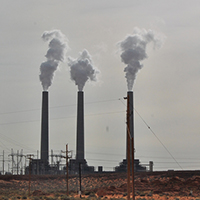
Power Plan Sent to the Cleaners
View the page for this story
EPA Administrator Scott Pruitt has started to rollback the Clean Power Plan, President Obama’s signature policy to curb carbon emissions from power plants. As Vermont Law Professor Pat Parenteau tells host Steve Curwood, the bid to dump the regulation may be largely symbolic as analyses show the U.S. is ahead of schedule on emissions reduction goals. Yet this move could help prolong the life of the coal industry, despite market forces that make cleaner energy more profitable. (11:19)
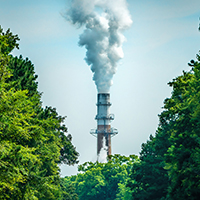
CO2 Boosts Photosynthesis
/ Savannah ChristiansenView the page for this story
As carbon dioxide levels climb in the atmosphere, plants step up photosynthesis. Living on Earth’s Savannah Christiansen reports in this week’s Note on Emerging Science that the increased carbon in the air also allows vegetation to use water more efficiently. (01:33)
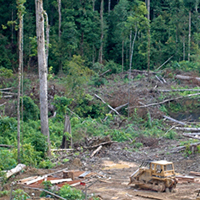
Tropical Forests Now Add To Global Warming
View the page for this story
Tropical forests have historically absorbed excess carbon dioxide, but new research indicates that these areas are now actually a net source of CO2. Selective logging that degrades these ecosystems, along with deforestation, releases more carbon into the atmosphere than the remaining trees can sequester. Living on Earth Host Steve Curwood spoke with the study’s lead author, Alessandro Baccini of the Woods Hole Research Center. (08:03)

Ancient Trees Race to the Top
View the page for this story
Trees tend to move to higher, cooler habitats in response to a warming climate. Now research on two pine tree species in the western US Great Basin that can live for thousands of years, the bristlecone and limber pines, shows that some species move faster than others. Young limber pines are taking over the higher real estate before their bristlecone cousins get there. Brian Smithers led the research at the University of California, Davis and tells host Steve Curwood this is partly due to the way the trees’ seeds are spread. It could be thousands of years before we really know how human-caused global warming has affected these enduring trees. (11:19)
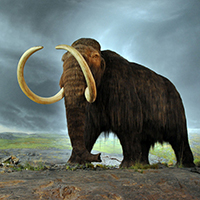
Rise of the Necrofauna
View the page for this story
Bringing extinct species like dinosaurs back from the evolutionary graveyard has long been a science fiction story. But with new gene editing technologies, cloning and careful selective breeding, this dream of de-extinction could soon be a reality. In her new book, Rise of the Necrofauna, science writer Britt Wray looks into real-life efforts to bring back lost species and what recreating an extinct creature would entail. She discussed with Living on Earth’s Helen Palmer the scientific, ethical, and cultural challenges of emerging de-extinction technologies and what conquering extinction could mean for conservation in the future. (14:44)
Show Credits and Funders
Show Transcript
HOST: Steve Curwood
GUESTS: Pat Parenteau, Alessandro Baccini, Brian Smithers, Britt Wray
REPORTERS: Savannah Christiansen
[THEME]
CURWOOD: From Public Radio International, this is Living on Earth.
[THEME]
CURWOOD: I'm Steve Curwood. Tropical forests have become a net source of carbon dioxide, instead of sequestering the global warming gas.
BACCINI: Until now the focus has been on deforestation, and we knew that there was something more happening and so this study is showing how the removal of single trees here and there and just the mortality of trees results actually in a significant amount of loss.
CURWOOD: Also – how the EPA decision to roll back the Obama era Clean Power plan puts a finger on the scale in favor of polluting fossil fuel.
PARENTEAU: Instead of letting the market continue to operate and build more solar, more wind, more natural gas, cleaner energy sources, the Trump Administration is actually trying to revive the coal industry when the market is determined to kill it.
CURWOOD: That and more, this week on Living on Earth. Stick around.
[NEWSBREAK MUSIC: Boards Of Canada “Zoetrope” from “In A Beautiful Place Out In The Country” (Warp Records 2000)]
[THEME]
Power Plan Sent to the Cleaners
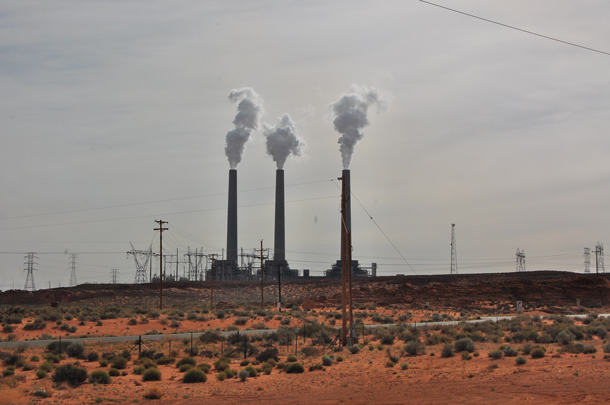
The Navajo Generating Station in Page, Arizona is one of the nation’s largest coal-fired power plants. Citing high costs to keep the plant running, the utilities that own the Navajo Generating Station voted in early 2017 to close the facility when the lease expires in 2019. (Photo: ilya_ktsn, Flickr CC BY-NC 2.0)
CURWOOD: From PRI, and the Jennifer and Ted Stanley Studios at the University of Massachusetts Boston, this is Living on Earth. I’m Steve Curwood.
To hear the Trump Administration talk about it, President Obama’s signature policy to curb carbon dioxide emissions from power plants, the Clean Power Plan, might as well be dead and gone. EPA Administrator Scott Pruitt said on October 9th he was rolling back those rules, a move aimed at getting the coal industry back on its feet. But thanks to a 2007 US Supreme Court decision, the EPA is required to limit emissions of CO2 emissions, as it is one of six greenhouse gases that “threaten the health and human welfare of current and future generations.” And Administrator Pruitt has yet to reveal how he would obey the law in the absence of the Clean Power Plan.
For insight we called up Vermont Law School Professor Pat Parenteau. Pat, great to have you here again.
PARENTEAU: Thanks a lot, Steve. Good to be here.
CURWOOD: So, how can the EPA repeal, roll back, something which addresses the problem of carbon dioxide as a pollutant?
PARENTEAU: Well, they can't completely repeal any rule regulating carbon from power plants because the Supreme Court has said in light of the finding made by the Obama administration that carbon pollution endangers public health and welfare, the Supreme Court said you must regulate carbon dioxide from power plants and other sources, so, Pruitt and company are not free to simply ignore the carbon pollution and the climate change problem that it creates, but they can make some changes to the rule. The question will be whether or not the changes they're talking about making are valid.
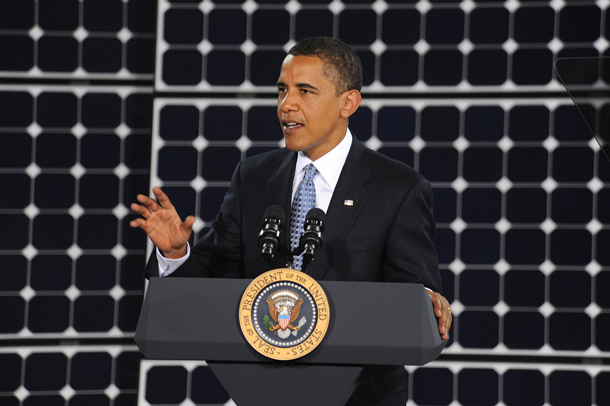
Former President Obama’s Clean Power Plan was key to his administration’s greenhouse gas reduction strategy for the U.S. Above, then-President Obama speaks about solar power during a visit to Nellis Air Force Base in Nevada, May 2009. (Photo: U.S. Air Force Photo/Senior Airman Brian Ybarbo, Flickr CC BY-ND 2.0)
CURWOOD: When they talk about repeal though, they make it sound like they're going to make it go away.
PARENTEAU: That's right. It sounds like this is the end of the road. It really isn’t. It's simply the beginning of another road.
CURWOOD: So, what could the EPA do to satisfy the requirement imposed by the United States Supreme Court to address carbon dioxide as a pollutant instead of the Obama-era Clean Power Plan?
PARENTEAU: Well, Pruitt has been known to advocate for regulating the power plants themselves, not beyond the fence line as it's called, and that would mean requiring better efficiency from these power plants which would result in a very modest reduction of emission. Something on the order of four percent is what EPA had estimated. And some environmental lawyers believe that Pruitt might be able to get by with such a minimal approach to regulating carbon. Others, including myself, think that the statute requires more and certainly the problem requires more than that. The statutory term that's at issue here is “the best” system of emission reduction, and certainly an emission reduction plan that only accomplishes a four percent reduction when much greater reductions are possible is not “the best”. So, I think there's a strong argument that if Pruitt takes the least restrictive approach to the problem, that could be vulnerable.
CURWOOD: So, to what extent is this move by Administrator Priutt really just a stall tactic to just keep the Clean Power Plan from moving forward?
PARENTEAU: That looks to be part of the strategy here, in part because in announcing the repeal of the rule, Pruitt also said he was going to open what's called an ‘advance notice of proposed rulemaking,” asking the open-ended question, “What do you think we should do about this problem of carbon pollution if anything?” And the announcement that he made, made it clear that he wasn't committing to actually proposing anything, and certainly not to a timeframe by which he would decide, so there is considerable speculation that, either by design or simply by running out of time, the first Trump Administration - and some would say hopefully the last - will not be able to accomplish actually completing a new rulemaking on a different plan. So, we're looking at a very long period of uncertainty for sure, several years.

President Trump campaigned on a promise to breathe new life into the beleaguered coal industry. Yet cheap natural gas and renewable energy have been pushing coal aside for years. (Photo: Max Philipps (Jeremy Buckingham MLC), Flickr CC BY 2.0)
CURWOOD: So, what happens during this period of time? The original rule is in front of the US Circuit Court of Appeals there in DC. I imagine that that court and the other parties will have an opinion about this development.
PARENTEAU: Oh, yes, there definitely is going to be a petition for review once the repeal rule is final. The DC Circuit, of course, as we know has already received a large amount of briefing on these very same legal questions that are now posed by Pruitt's action. They heard a full day, eight hours of argument, and they heard the arguments as the full court. So, they've heard already, all of the issues and all of the arguments back and forth and probably are poised to render a decision on how this term and how this statute should be interpreted, whether it should be interpreted in the way that Pruitt wants to propose, which is the least restrictive it could be, or more closely aligned with what Obama proposed, which would have been about a 32 percent reduction in emissions by 2030.
CURWOOD: Now, the Obama Clean Power Plant set different standards for coal versus natural gas, and it only included large emitters. How fair was it to make it harder for coal to comply, and what about the smaller sources?
PARENTEAU: Well. coal is a third of our emissions, so it was clearly appropriate to zero in on coal-fired power plants as the primary sources that had to be controlled if we're going to get these emissions down to the levels that the science is telling us we need to. In fact, they need to go much further than what the Obama administration plan was proposing. Gas plants at the combustion stage are much less polluting than coal plants, so it won't be difficult for the gas-fired power plants to meet these new standards. In fact, gas is a key strategy in shifting from coal to cleaner sources, and smaller sources of emissions could also eventually become regulated. EPA was taking a sector by sector approach, starting with power plants, but there are many other industrial sectors that could also be the subject of carbon pollution regulation.
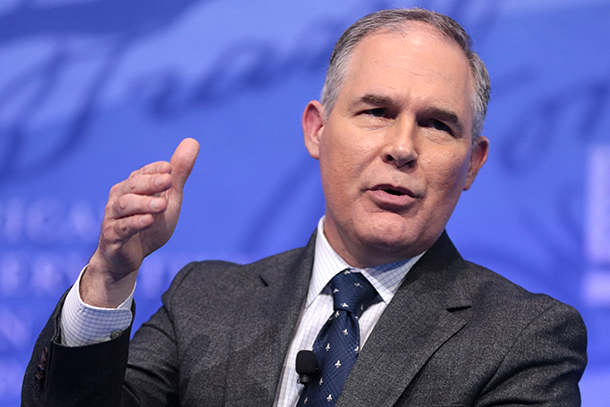
EPA Administrator Scott Pruitt. (Photo: Gage Skidmore, Flickr CC BY-SA 2.0)
So, EPA was faced with a major challenge, which was, as I say, a court decision saying they must regulate. A statute that says you should do it in the best system approach you can come up with, and I think EPA did a very credible job in looking at the grid system of America and saying, “Here are some flexible ways in which we can get these emissions down, continue to generate the electricity we need, keep the consumer rates low enough that people can afford the electricity”. They had to balance all of that and they had to come up with a plan that would actually work to achieve the reductions and not do unnecessary damage to our electricity system.
CURWOOD: Pat, Administrator Pruitt is on the record as being very skeptical of climate disruption and the human connection to it and such. How honest do you feel the administration's claim here is that, “Oh, the Clean Power Plan wouldn't really provide the health benefits that the law would require?”
PARENTEAU: Well, I think they're being very disingenuous. One of the great advantages of regulating these coal-fired power plants and shifting away, frankly, from coal is that you have tremendous health benefits from respiratory ailments, from asthma attacks, from people missing work, from premature death, from cardiovascular disease. There's really no dispute that coal is probably one of the most deadly forms of electricity generation we have in terms of the number of people that are exposed to these emissions. So, by reducing carbon we're also creating all these other health benefits. In this latest round of the proposal to repeal the Clean Power Plan, Pruitt and company have said we're not going to count any of those benefits because we don't think they're related to the carbon reduction goals of the statute, and that's pretty myopic and pretty backward way of thinking.
So, the science is getting stronger and stronger. We've seen what incredible monster storms climate change is creating with the four major hurricanes that have hit us just this season, and we're still not done, and the wildfires burning across the landscape of northern California. The climate scientists are drawing a clear link that these events are greater in terms of their intensity and damage than they would be without the global warming effect of all these greenhouse gases. So, everything that we see around us every day is telling us we need to move much more aggressively to reduce these emissions, and the Pruitt-Trump administration are marching in exactly the wrong direction.
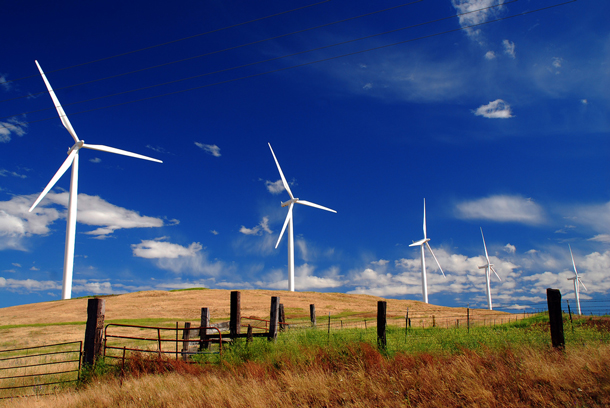
Wind energy is already replacing some of the power grid needs previously met by coal-fired power plants. (Photo: Gord McKenna, Flickr CC BY-NC-ND 2.0)
CURWOOD: Pat, given that market forces - I'm talking here about a continued drop in the price of wind and solar and the flooding in the market with cheap natural gas -- we're already pushing out coal-fired power plants. How much of an impact do you think this bid to replace the Clean Power Plan will have on the nation's energy makeup?
PARENTEAU: Well, a lot of people do believe that we're going to achieve the goals of the Clean Power Plan even without it. In fact some recent studies suggest that we're already about two-thirds of the way to the 32 percent reduction goal that the Clean Power Plan was established. Even when that plan was approved, a lot of people were saying it was much too modest. It's pretty clear that we can do a lot better. We can get 40 or 50 percent, perhaps, if we really get serious about it. So, it may be that we'll accomplish these things even without the plan, but it's also true that the plan is going to cause some states, particularly those that are heavily dependent on coal, to continue to rely on coal instead of moving more aggressively off of it, and there may be some backsliding. It could be that gas prices start to increase and the operation of gas-fired power plants declines. So, the Clean Power Plan was kind of like a bulwark against maybe backsliding on some of these emission reductions that we are seeing.
CURWOOD: Hey, in making this announcement Pruitt says the EPA doesn't know yet whether it will promulgate a new rule. What's going on here? I mean, what's this calculation?
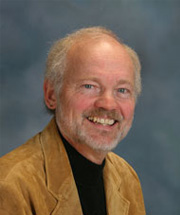
Pat Parenteau is a professor at the Vermont Law School, where he teaches on environmental litigation. (Photo: Vermont Law School)
PARENTEAU: Well, it seems to be a calculation to appease the coal industry. The coal industry wants no plan whatsoever, in fact, the coal industry has been persuading Secretary Perry at the Department of Energy to propose a rule that would require full cost recovery for coal and nuclear regardless of how much money a kilowatt of energy costs from a coal-fired power plant, they're going to be able to recover that. It's a major disruption of the energy market and it's all of a piece. I mean the repeal of the Clean Power Plan, this proposal to award the coal industry a subsidy in effect for full-cost recovery, at the same time that the natural gas is putting coal out of business, I mean this is a major national energy policy that's distorted beyond belief because instead of letting the market continue to operate and build more solar, more wind, more natural gas, cleaner energy sources, the Trump administration is actually trying to revive the coal industry when the market is determined to kill it.
CURWOOD: Pat Parenteau is a Professor of Law at Vermont Law School. Thanks so much for taking the time today, Pat.
PARENTEAU: You're welcome, Steve.
Related links:
- Bloomberg: “Trump Administration Formally Proposes to Rescind Obama’s Clean Power Plan”
- NYTimes: “E.P.A. Announces Repeal of Major Obama-Era Carbon Emissions Rule”
- About Vermont Law School Professor Pat Parenteau
[MUSIC: Huancara, “La Telesita” on Sounds Of Indian Summer-Contemporary Native Music From the National Museum Of the American Indian, Smithsonian Institution.]
CURWOOD: Coming up, why ancient pines are slowly climbing mountains.
That’s just ahead on Living on Earth.
ANNOUNCER: Support for Living on Earth comes from the Gordon and Betty Moore Foundation, and from a friend of Sailors for the Sea, working with boaters to restore ocean health.
[CUTAWAY MUSIC: Huancara, “La Telesita” on Sounds Of Indian Summer-Contemporary Native Music From the National Museum Of the American Indian, Smithsonian Institution.]
CO2 Boosts Photosynthesis
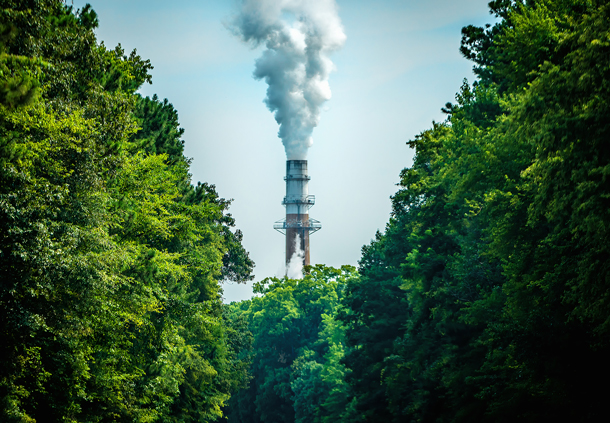
As carbon emissions rise, plants are responding by performing more photosynthesis and using water more efficiently. (Photo: Bill Dickinson, Flickr CC BY-NC-ND 2.0)
CURWOOD: It’s Living on Earth, and I’m Steve Curwood. Just ahead, how tropical forests have become a net source of carbon emissions. But first this note on emerging science from Savannah Christiansen.
[MUSIC: SCIENCE NOTE THEME]
CHRISTIANSEN: As carbon dioxide builds up in the atmosphere, plants and their energy generation process, photosynthesis, are bound to be impacted. Scientists suspected that more carbon in the air would provide more fuel for photosynthesis so plants could grow more and store more carbon. Now a study led by Scripps CO2 program head, Ralph Keeling, has confirmed this suspicion, and helped explain a mystery about atmospheric carbon.
Atmospheric carbon has two different forms, or isotopes, carbon-12 and carbon-13. Carbon-13 is less common, yet the researchers found that it’s building up in the atmosphere more quickly than expected. Something is taking out extra carbon-12.
To find out why, the team measured ratios of these carbon isotopes from different areas and from archived samples. Plants find carbon-12 easier to use for photosynthesis, so they prefer it. And the sample measurements suggest that they are becoming increasingly picky, using even more carbon-12 and leading to the imbalance.
The researchers note that the current plentiful level of carbon-12 also allows plants to adjust their stomata, the holes in their leaves that control carbon intake, so that they can actually minimize water loss. And while many implications of this are still unclear, it’s possible that, as carbon dioxide levels rise, plants will have a tool to allow for more growth, even when water is scarce.
That’s this week’s note on emerging science. I’m Savannah Christiansen.
[MUSIC: SCIENCE NOTE THEME]
Related links:
- Link to the study in Proceedings of the National Academy of Sciences: “Atmospheric evidence for a global secular increase in carbon isotopic discrimination of land photosynthesis”
- Washington Post: “Some good news about global warming for once -- plants are speeding up their use of carbon”
Tropical Forests Now Add To Global Warming
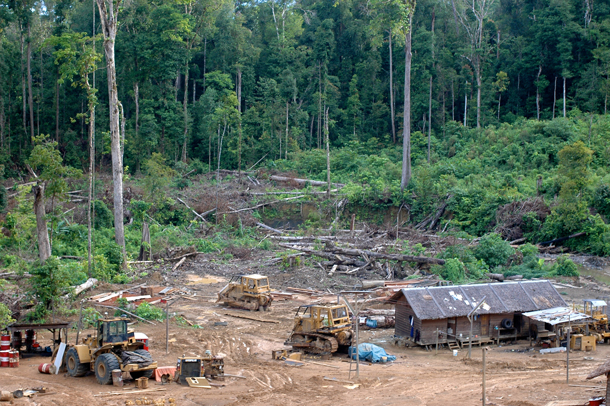
A logging area in Gunung Lumut, East Kalimantan, Indonesia. (Photo: Jan van der Ploeg/CIFOR, Flickr CC BY-NC-ND 2.0)
CURWOOD: There has long been a conventional wisdom that tropical forests soak up carbon and help blunt the impact of industrial greenhouse gas emissions. But new research is finding that the tropics are actually adding to the problem of global warming, rather than absorbing carbon dioxide. In other words, the tropics are now a net carbon source rather than carbon sinks.
Alessandro Baccini of the Woods Hole Research Center is the lead author of this study, recently published in Science Magazine. He joins us now. Welcome to Living on Earth. Alessandro.
BACCINI: Thank you for having me.
CURWOOD: Now, your research finds that the world's tropical forests have now net carbon emissions of some 425 terragrams of carbon annually. What does that mean exactly, and how can the average person conceptualize that number?
BACCINI: Well, you can think about that is more than all the emissions that the cars and trucks in the US are emitting every year. It's almost close to all the emission of the transportation of the US.
CURWOOD: So, when did the tropics go from being a carbon sink to a net carbon source?
BACCINI: In our study we look only at the period between the year 2003 and 2014, and what we see that, if we can see the entire tropics, they always have been a source during this period. But it really varies depending where you look at. So, if for example you start to look at different countries, you see that some countries are still a sink or other countries in the course of this period actually change from being a sink to being a source, and just to give you an example, the Democratic Republic of Congo, DRC, went from being a sink until 2007 and then started to become a source after 2007. So, it really changes.
CURWOOD: So, what methods did you use to collect all this data on the carbon density of these forests?
BACCINI: So, you know, what we have to measure is the weight of the trees, the weight of the vegetation. So, the best way, the most accurate way would be to in essence chop down all the trees and then weigh all the trees, and you can understand that is impossible, and we don't want to do that of course. So, the other option is to actually collect those measurements in some samples. So, you go, and you try to collect samples that are representative of the variability of the carbon density.
The problem is that our study region is pretty big, is entire topics. And so, what we did here is, we combined field datum that we collected across the tropics with satellite observation. The advantage of working with satellite observation is that they’re cost effective in covering a very large area. And, if you are able to use your field datum to calibrate a statistical model that relates your field measurement with a measurement of the satellite, you are in good shape because then everywhere you have observation from the satellite you can actually generate an estimate of the carbon density.

Aerial view of the Amazon Rainforest, near Manaus, Brazil. (Photo: Neil Palmer/CIAT, Flickr CC BY-NC-ND 2.0)
CURWOOD: What are the biggest threats to the ability of these forests to store carbon?
BACCINI: The threats are mainly anthropogenic. The first one of course is deforestation, but one aspect of the study that we consider interesting is that for the first time we were able to quantify the losses that are due also to degradation and disturbance, something that was not possible to do until now at this scale. Degradation in our study is the process that decreases the amount of carbon stored in the forest. It doesn't change the land cover. It doesn't change the land use. It is still a forest. It is just that it doesn't store the amount of carbon that it was able to store before. Until now, the focus has been on deforestation, and we knew that there was something more happening than deforestation, and so the study is showing how removal of single trees here and there and just the mortality of trees in the forest results actually in a significant amount of loss, and what is interesting now to better understand is the degradation. Is it again anthropogenic or is it sort of natural disturbance?
CURWOOD: What needs to change the policy level to reverse the carbon math of the tropical forests? There was a program the UN had, REDD, Reducing Emissions from Deforestation and Degradation. It was supposed to address tropical forests. What happened? What's going on?
BACCINI: I think REDD was and is a positive initiative. As you said, REDD, you know the second D of REDD is for “degradation”, and until now that was very difficult for anybody to be able to report on the second “D”. If you look at the result of our study, almost 70 percent of the emissions in the tropics are actually coming from the second D, from degration. So, from a policy point of view, if you only focus on deforestation, you tackle only part of the problem.
CURWOOD: What are the major reasons that forests are degraded? What happens to cause degradation?
BACCINI: Degradation is generated by anthropogenic activities, for example, selective logging. But what we find is that one process that is very common actually in developing countries is just the harvest of wood for energy. If you think about, even now in developing countries almost 70 percent of the energy supply comes from charcoal, from wood. On the other end there are natural drivers of degradation that consist in for example fires, mortalities due to drought, mortalities due to insect or a series of diseases that get their way in when the forest is under stress.
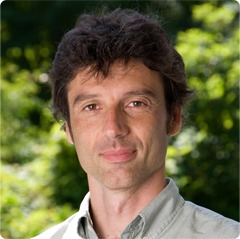
Alessandro Baccini is an Associate Scientist at the Woods Hole Research Center. (Photo: courtesy of the Woods Hole Research Center)
CURWOOD: What can you tell us about the carbon-absorbing capacity of other kinds of forests around the world?
BACCINI: That's a very important point. So what is happening outside of the tropics, well, a lot of forests actually are growing. One region that is very interesting for us right now is actually the Boreal ecosystem where, thanks to climate change, the conditions are changing so that we see a greening of this region but when we will finish our analysis we will be able to actually quantify if it is a sink or a source and have a better understanding of what is happening outside of the tropics.
CURWOOD: This is frankly rather disturbing discovery, that we're losing a lot more carbon from tropical forests than we were thinking previously. Please give me a reason to be hopeful about your findings.
BACCINI: Well, actually I think that it's a great news because forests right now are actually a source, we can actually invert this trend and make the forest a sink. And if you think about that, if we can, if we are successful in inverting this trend, we will be able to remove quite a bit of carbon from the atmosphere and, in my view, forest is the only technology that it is ready, safe, and available at such scale in order to fight climate change. And, while you do that, you don't only remove carbon from the atmosphere but you also, well, you conserve biodiversity. You improve the quality of water. You provide shelter and life to a lot of people, indigenous people or people in developing countries that use, and they need this type of ecosystem to live.
CURWOOD: Alessandro Baccini is a scientist at the Woods Hole Research Center. Thank you so much for taking the time with us today, Dr. Baccini.
BACCINI: Thank you so much for having me. Bye-bye.
Related links:
- The original study in Science: “Tropical forests are a net carbon source based on aboveground measurements of gain and loss”
- Guardian: Alarm as study reveals world’s tropical forests are huge carbon emission source
- Woods Hole Research Center
- More about Alessandro Baccini
Ancient Trees Race to the Top
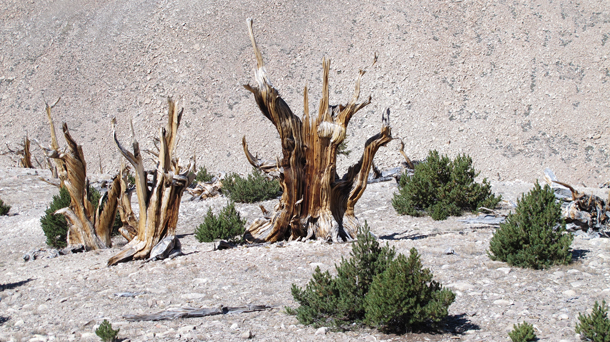
Above, young limber pine trees have taken root next to old, dead bristlecone pines in the White Mountains of California. (Photo: Brian Smithers)
CURWOOD: Trees are on the move. The warming climate is prompting some species to head up mountainsides to higher, cooler elevations. Of course individual trees can’t pick up their roots and climb, but over time saplings on uphill side tend to do better than their downhill brethren. Over time the species as a whole shifts up. And now new research from the University of California Davis reveals an unexpected wrinkle on this upward trend. It appears the long-lived limber pine is leapfrogging over its cousin the even longer living bristlecone pine in the race to the top.
Brian Smithers led the research at the U.C. Davis. Brian, welcome to Living on Earth.
SMITHERS: Thanks for having me.
CURWOOD: I gather as an avid hiker as well as a scientist you're quite familiar with the bristlecone and limber pines, trees that not only grow but thrive in astonishingly harsh conditions. Please describe them for us them and where they live.

A young limber pine grows close to a stand of larger, older bristlecone pines on Charleston Peak in the Spring Range of southern Nevada. (Photo: Brian Smithers)
SMITHERS: They're found throughout the Great Basin which, you know, is known as being a harsh environment in general, but they're also found in what we call the Sky Islands, these super high mountains throughout the Great Basin which not only have the benefit of being dry but also brutally cold in the winter and then pretty warm in the summer. So, they sort of get the worst of all worlds as far as climatic or weather conditions go. Where they grow in good conditions they actually look like a normal, pretty-looking tree, you know. They look almost like a Christmas tree. But where they grow in rougher conditions, on ridges or a tree line, they just get beaten down by really high winds blowing snow, blowing ice and they take on sort of a representation I think of those conditions – gnarled twisted wood, half the tree dead or dying, but just continuing to push through. That's kind of the amazing thing about them is their ability to survive these crazy conditions and their ability then to sort of take on the shape of really rough conditions.
CURWOOD: And these trees can be, well, they can get to be quite old, I gather.
SMITHERS: Yeah, depending on what you call an individual and there's some debate about that, but as far as individual organisms go on Earth, there's nothing older. The oldest known tree is one we call Methuselah. It's a little over 5,000 years old.
CURWOOD: Now, your study is about what you call a leapfrogging effect. There’s one species of tree, the limber pine which I guess only lives about 2,000 years as opposed to 5,000 years, a little youngster there; whereas, the bristlecone pine can live 5,000 years, and they are sort of in a race to the top. As things get warmer and warmer these trees seem to want to move up higher and higher. Why are you studying these trees?
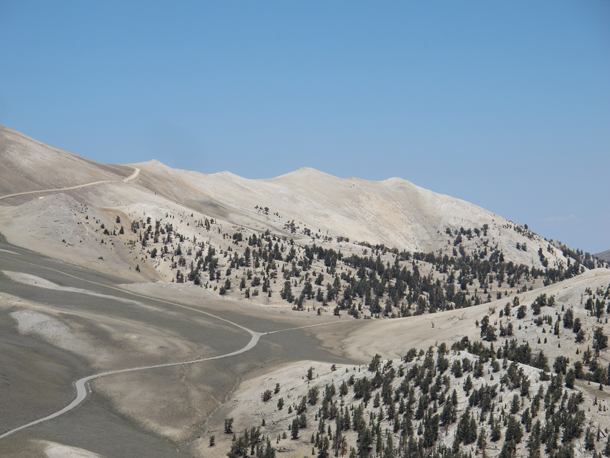
Treeline in the White Mountains. The older trees are mostly bristlecone pine, but younger limber pines now dot the landscape just above the old treeline. (Photo: Brian Smithers)
SMITHERS: The reason we're looking at this, first of all, we wanted to look at how species, how trees in particular are responding to climate change, tree line is a really nice experimental spot to do that because it's a real clear line of a species range edge, a species range margin, because it's controlled almost exclusively by temperature. And so when we want to see, OK how are species responding to climate change, we ought to expect tree line to be moving up slope, and in fact it is. There are lots of studies all over the world where it is. There some where tree lines are not moving up, but in the Great Basin we could see it on the landscape, but it didn't look like we thought it ought to look, just by walking around. bristlecone pine, adults, dominate typical tree line stands in most of the Great Basin, and you are hard pressed to find limber pine adults in those forests right at tree line. And yet the vast majority of the trees establishing above that tree line turned out to be this limber pine which is typically found further down slope of bristlecone pine.
So, somehow it appears that the seeds are dispersing from well down slope to above tree line, that's the leap frog effect, and establishing quite a bit faster than bristlecone pine is, and so you're getting this interesting sort of down slope band of limber pine, then a band of bristlecone pine, and then another band upslope of limber pine.
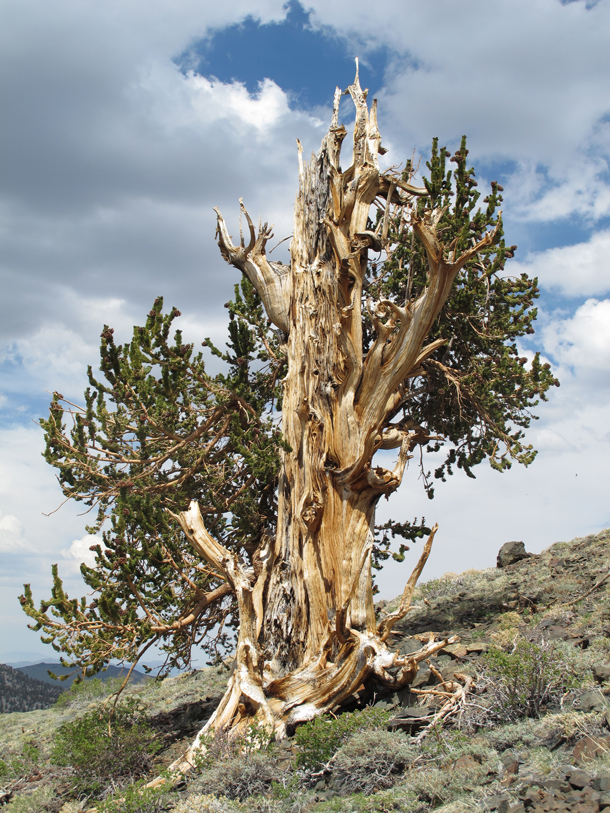
With a lifespan of at least 5,000 years, bristlecone pine trees are believed to be the oldest individual living plants on Earth. (Photo: Brian Smithers)
CURWOOD: So, in this race to respond to climate change, the limber pines are going faster, although something that lives for a couple of thousand years, I'm not sure that “fast” is exactly the right word.
SMITHERS: [LAUGHS:] Less slow maybe? Yes, they are moving faster, and I think even when we think in terms of 2,000 years, 5,000 years, we're talking about an effect that's happened in the last 50 years, and that's pretty fast. You know the individual trees for limber pine can live 2,000 years, for bristlecone pine can live 5,000 years, but a young tree can move about the landscape and responds to changing climate pretty quickly and, in fact, that's what we're seeing. And so this process does appear to be happening pretty quickly, certainly relative to the ages of these species.
CURWOOD: How much is the climate changing in the bristlecone pine, limber pine territory?
SMITHERS: We do have documented evidence of climate change. We've seen a little bit more than one degree Celsius average increase in temperature over the last 100 years based on these climate reconstructions, and so it's warmer, it's definitely warmer. We know that must have impacts on snow, the amount of time that the snow is on the landscape, maybe even how much snow is on the landscape, and that snow is a really important thermal barrier during the winter. It actually keeps the trees a little bit warmer, having that snow because it's much colder than freezing in these mountains typically during the winter.
CURWOOD: So, these trees can both survive in the same climate, right? So why are the limber pines moving ahead?
SMITHERS: Yeah, they survive in more or less in the same climate. Bristlecone pine can handle a little colder, limber pine maybe a little warmer, a little drier. We think they're moving ahead because they've got a dispersal advantage, and what that advantage is, there's this bird called the Clark's nutcracker which prefers the large nutritious seeds of limber pine to bristlecone pine. Bristlecone pine seeds are pretty small and they are winged. They're adapted to just be dispersed by gravity and a little bit of wind. But limber pine, the cones don't even open up on their own until much later mostly the cones get picked apart by this bird called the Clark's nutcracker, which harvests the seeds and they cache individually tens of thousands of these seeds per year all across the landscape.
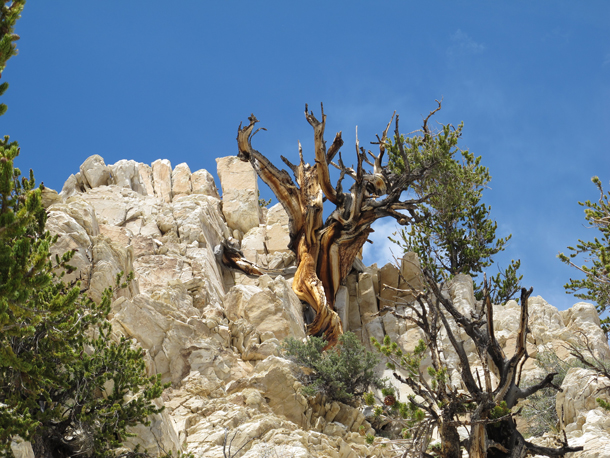
Bristlecone pines sometimes appear to be growing straight out of the rocks. (Photo: Brian Smithers)
Studies show that they can travel up to five miles in any direction which really gets them out of all over the place and so they're caching these seeds all over some of which they eat over the winter but a lot of them they don't get to, and so those seeds get buried at an optimal depth for germination. They get hidden from seed predators. They get just a real clear advantage over bristlecone pine and when we've got this really great - You know, I sort of liken it to a real estate boom above tree line - it's really a large area that's now available, climatically available, and the first one there can really define what that forest is going to look like going forward.
CURWOOD: Brian, I'm confused about one thing there. Why are the limber pines a lot less common with the bristlecones right now if they can both survive in basically the same climate and the limber has a more efficient way of getting their seeds distributed? Why did the bristlecone have such a hold on the basic tree line?
SMITHERS: That's a really good question. I'm afraid I don't have a great answer for that because we won't know the results of the phenomenon we're seeing now for 5,000, 10,000 years.
I've got a couple of theories on that. The first one is that for these trees, for this species, they're still sort of coming out of a really cold period we call the Little Ice Age that was sort of wrapping up around 1850, and during that time there was no regeneration at all in these sub-Alpine forests. It was just too cold, and it's likely that during that time period, if there were limber pine around, it probably got too cold for them during that period, and they died out. And so, maybe what we're seeing is some combination of these high mountain sort of, still kind of slowly coming out of this Little Ice Age coupled with human-induced climate change, global warming, allowing limber pines to move back into these systems.
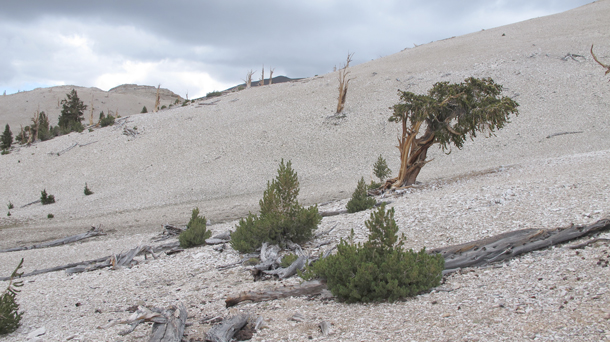
Above, a single, large bristlecone pine is surrounded by much smaller, younger limber pines in the White Mountains. (Photo: Brian Smithers)
That's one theory. The other theory is that over the long haul bristlecone pine is just a stronger competitor and that would mean they've been able to exclude limber pine, and those two theories are really at odds going forward. It means that if it's "A," you know, if it's climate, we can expect that limber pine would stick around in these newly established forests. If it's "B", if it's bristlecone pine is a stronger competitor, maybe limber pine gets in there now but over the long haul, 10,000, 20,000, 30,000 years, we'd expect bristlecone pine to ultimately replace limber pine and their march up slope in response to climate change.
CURWOOD: Brian, tell me, how important are the bristlecone pines and the limber pines to their ecosystem, especially places where the dominant? I'm thinking of the White Mountains, there, in California.
SMITHERS: Right, both species really are, are a foundation species in these forests. Without either one of them you're looking at a sagebrush scrub or alpine environment, and the difference between a shrubland and a forest or an alpine environment and a forest are night and day, those are very different systems, and so you know these forests bring with them a lot of species, and they contribute substantially to the diversity of the White Mountains. There are forest bird communities that are there that certainly provides refuge for larger game, things like black-tailed deer. So, these forests are really important.Whether there is a substantial difference between bristlecone and limber pine as far as their ability to create that ecosystem, yeah, I don't know that there is a huge difference.
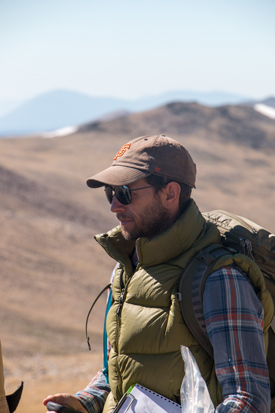
Brian Smithers, seen here doing research in the field, in 2017 was finishing up a Ph.D. program in ecology at the University of California, Davis. (Photo: Marc Hoshovsky)
CURWOOD: Now, you said that perhaps the oldest tree is named, Methuselah, the oldest bristlecone. What's your favorite bristlecone pine, and does it have a name?
SMITHERS: Oh, that's a good one. My favorite bristlecone pine is off the beaten track. There's a naturalist of great fame in the White Mountains. His name is Tim Forcell, and he's been running around those mountains for 20, 30 years, long time, and he took me to this place called the Boulevard of the Giants, which is basically unknown I think to most people. He gave it that name. It's just full of these very large, very old trees with just the most beautiful forms imaginable. There's one particular tree in that grove that - It defies explanation truly but it's just a phenomenally beautiful tree and it's clear it's seen a lot of days, some good, some not so good evidently.
CURWOOD: So, it's on the gnarled side or it's on the very tall and proud side?
SMITHERS: It's on the gnarled side. I think I tend to appreciate generally things that sort of, they get by. They live on the edge, and I think that's what drew me to these forests in these Bristlecone pines to begin with because their ability to withstand takes a toll on them, but they do it.
CURWOOD: Brian Smithers is just about all done with his PhD from the University of California Davis. Thanks so much for taking the time with us today.
SMITHERS: Thank you. It was really my pleasure.
Related links:
- The study in Global Change Biology: “Leap frog in slow motion: Divergent responses of tree species and life stages to climatic warming in Great Basin subalpine forests”
- Los Angeles Times: “Ancient bristlecone pine forests are being overwhelmed by climate change”
- About Brian Smithers’ research interests
[MUSIC: R. Carlos Nakai & Will Clipman, “First Morning” (Putumayo Version) on Native America, by Will Clipman, Putumayo World Music, originally published on Awakening the Fire, Canyon Records.]
CURWOOD: Coming up, just maybe a way to bring back the extinct woolly mammoth and passenger pigeon. That’s just ahead here on Living on Earth. Stay tuned.
ANNOUNCER: Funding for Living on Earth comes from you our listeners, and United Technologies - combining passion for science with engineering to create solutions designed for sustainability in the aerospace, food refrigeration and building industries. UTC companies such as Otis, Carrier, Pratt & Whitney and UTC Aerospace Systems are helping to move the world forward. This is PRI, Public Radio International.
[CUTAWAY MUSIC: Miles Davis & John Coltrane, “When I Fall In Love” on Music From the American Century.]
Rise of the Necrofauna
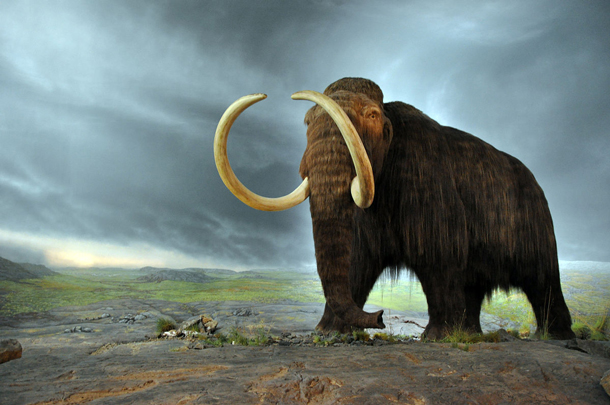
Researchers at Harvard University are currently editing Asian Elephant genomes to make Woolly Mammoth-like embryos. (Photo: Thomas Quine, Flickr CC BY 2.0)
CURWOOD: It’s Living on Earth, I’m Steve Curwood.
Species are currently disappearing at such a rate that the loss rivals the great extinction events of the past, such as the one that killed off the dinosaurs some 65 million years ago. Fiction has given us an antidote, of course. Novelist Michael Crichton portrayed scientists able to use DNA from fossils and bring dinosaurs back to life in Jurassic Park. And now some recent scientific advances have shifted the idea of bringing back the woolly mammoth or the passenger pigeon from the realm of science fiction into something more like fact.
Still, that doesn’t get rid of huge obstacles that stand in the way of de-extinction, and science writer Britt Wray has chronicled technical, ethical, and legal problems in her new book, Rise of the Necrofauna,. She spoke with Living on Earth’s Helen Palmer.
PALMER: Now, Britt Wray, your new book is called Rise of the Necrofauna. Why did you choose that term...necrofauna?
WRAY: I get a lot of puzzled looks about that term. It's a funny one. I first heard it used by a futurist by the name of Alex Steffen, and he was using it to describe a possibility with de-extinction that we might just pursue this recreation of proxies, of extinct species, in order to make humans feel good and produce what he called “charismatic necrofauna”, so extinct animals that we prefer to see because they're majestic, cute, cuddly, beautiful, something inspiring to look at and be around rather than actually paying attention to a variety of other species that we could have chosen instead of candidates for de-extinction. So, it was a bit of a tongue in cheek choice to call it Rise of the Necrofauna. It's a bit ominous sounding, but it does raise this question, you know. If forms of extinct animals can be brought back to life, one of the big ethical issues that we need to contend with is how we make the choice around which ones to select for de-extinction projects.
PALMER: Obviously, it's an interesting challenge, this idea of the de-extincting species, but why do scientists really want to do it in the first place?
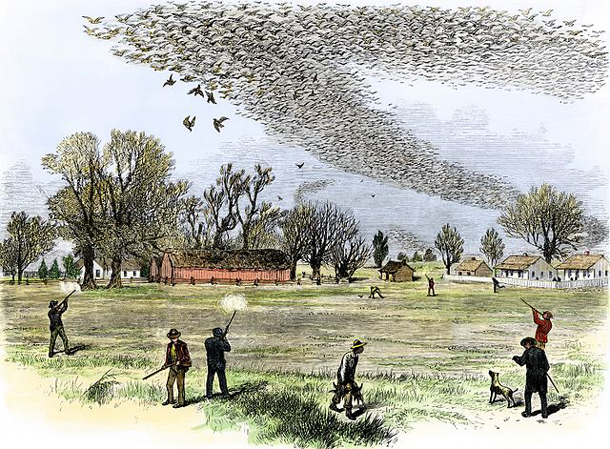
The extinct passenger pigeon, once abundant across North America, is the subject of de-extinction efforts. (Photo: Smith Bennett, Wikimedia Commons)
WRAY: The main reason that people who are advocates of de-extinction or even the scientists working on it put forth for why this would be a good idea is that there are ecosystems that have changed dramatically since particular keystone species, the really prominent species that had an important functional role disappeared, and the idea is that, if we could create new animals that have reconstituted genes from extinct species in them that would allow them to carry out the roles of those extinct species, maybe their being put back in those environments that have become ecologically de-pauperate, maybe that could be improved by having some kind of acting species that could carry out those lost roles.
PALMER: So, what kind of species are at the top of the list?
WRAY: Well, the ones that people are working on include the passenger pigeon, the woolly mammoth, the gastric brooding frog, aurochs, the list goes on. It's still relatively fringe. There aren't tons and tons of projects, but there's a handful of a variety of different species that people have either tried and stopped or are currently looking at doing.
PALMER: So, what kind of techniques would you use to actually recreate an extinct animal?
WRAY: One is back breeding. We can think of the way that humans have bred dogs from wolves by selecting traits in wolves that they found desirable and crossing them together over multiple generations to arrive at a variety of dog breeds that we now know and love, but it can also work to breed a form of animal that is no longer here. So, the ancestor of all of today's cattle is something called the “aurochs”, and we know what they looked like, we know what their horn shape was, the coloration, all sorts of characteristics we can then select for in living cattle breeds that we cross over successive generations until we get something that looks pretty much like the original, extinct ancestor.
Then, there's also cloning. So, many people are familiar with the most famous adult animal clone we've had on Earth, Dolly the sheep, who was created by a process called somatic cell nuclear transfer, and that requires a cell from the animal that you want to clone that is whole and intact. The thing with an extinct species is that you'd be using preserved tissue from an animal that is no longer here, but that has been frozen immediately after it died, and when you're talking about a lot of animals that have been gone for a long time like the woolly mammoth, for example, it's really difficult to find a perfectly intact a woolly mammoth cell that has that nice nuclear genome all bound up that makes cloning possible. And so, then you have to look in places like Siberia and pull chunks of mammoth tissue out of the permafrost and see if you can find anything that's intact, and so far that quest is still on.
PALMER: There's back breeding, there is cloning, there is finding extinct DNA and trying to revive it. Any other techniques they're using?
WRAY: So, the last part that I didn't talk about yet, the last approach that people are using, is gene editing. So when you don't have a full intact genome inside a nicely preserved nucleus of an extinct animal, you can potentially edit specific pieces of the extinct animals DNA into an animal that most closely resembles it that is living. So, in the case of the woolly mammoth, that's the Asian elephant. And so you use the living animal the genome as the base template that you then edit to insert the genes of interest to basically then tinker and cobble together a proxy of the extinct animal in the genome of the living animal.
So, you can introduce the gene that gave it the thick shaggy iconic hair or fatty insulating skin or the ability to bind and release oxygen in its blood at cold temperatures which elephants can't currently do. So then you end up essentially with a hairy elephant that can live and act potentially like the woolly mammoth you want to create.

Back breeding, a process sometimes used breed dogs that look like their ancestors, is a popular form of genetic modification in de-extinction efforts. (Photo: Albert Herring, Wikimedia Commons)
PALMER: Now, obviously the new gene editing technique CRISPR, which has received a huge amount of press because it's so capable of fixing genes in humans that are defective, has given a new lease of life to this as a possibility, this idea of recreating, say, a mammoth with an Asian elephant as a mother.
WRAY: CRISPR is the blockbuster tool of a variety of de-extinction projects, and with the woolly mammoth project, for example, at Harvard there are already a variety of dishes full of Asian elephant cells that have been edited to have woolly mammoth genes inserted into the cells using CRISPR, and the idea that they're testing out, what is the effect of putting a red hair or a shaggier hair gene into elephant cells, what does that cause in terms of cellular change? And eventually, once they understand that for all the traits that they want to edit in, they plan to make all of the edits simultaneously in a master cell.
PALMER: Given the cost and the difficulty of actually creating animals by any of these techniques you've talked about, we may be able to get one, two, five, but if you want to reintroduce them to a landscape, you'll need hundreds. I mean, that seems implausible. So, is what we're looking at a kind of like quasi-woolly mammoth in a zoo, the one, the only one there is?
WRAY: For a time, yes. If de-extinction is successful in terms of producing individual animals that fit the definition of what you call the revival, you know, let's say a hairy elephant that can live in the north. It is going to be that you don't get a full species right out of the gate. It's simply not possible, so you need to build that up and you also need to be able to study their welfare. You can't simply create them in a lab and let them loose in the Yukon or northern Siberia. So yes, captivity is part of the formula here.
PALMER: Wouldn't we be better off trying to preserve the actual threatened species we've got at the moment?
WRAY: Personally, I definitely think so. However, there are certain things about de-extinction that may be able to transfer over into helping endangered species. The researchers at Harvard in George Church's lab who are working on the woolly mammoth resurrection are also now working on creating a CRISPR-based system to help elephants that are dying from EEHV which is a herpes virus which is wiping them out in captivity and in the wild. So, it was these researchers while working on the mammoth project needing to look into Asian elephant biology for that project that led them to discover this herpes problem, and they realized, “Oh the tools we're using for de-extinction might also be able to create a gene editing system that detects the herpes virus and disable that, cuts it up, chops it with CRISPR before it actually infects the elephants.”
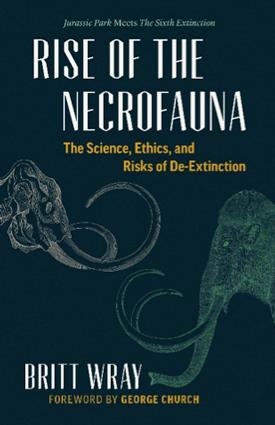
Rise of the Necrofauna looks at the scientific, ethical, financial, ecological, and legal aspects of modern de-extinction efforts. (Photo: courtesy of Elizabeth Shreve)
PALMER: Well, that sounds entirely plausible, and then you look at say a species like the cheetah, which has a fantastic genetic bottleneck. They, too, are in danger because of their genetic similarity. So, you know, maybe indeed you could help a species like that.
WRAY: That's a great point, and that is a key way that these tools are increasingly being used for transgenic conservation or synthetic biology conservation, whatever you want to call it. We're realizing that it's not just about taking extinct genes and turning them into a new form of a genome, but we can take any genes, you know, living or extinct and apply them into a variety of organismal genomes.
So black-footed ferrets are another species that people are looking at here because they have such low genetic diversity. Their founding population had very few individuals of the ones that are around today, and so they're really inbred, and that causes all sorts of problems for them, but if you can take genetic material from long dead ferrets that had more genetic diversity before they went through a population bottleneck which have been stored in cryogenic freezers, and you can edit that diversity into the living ferret gene pool, can we not then help the existing ferrets and increase their biodiversity that way.
PALMER: Of course, there is another sort of moral hazard which is that, if you could indeed bring animals back from the dead, if you managed to recreate these animals, then there's so much less requirement to actually preserve the ones we've got in the threatened ecosystems at the moment. So why would you not cut down an old growth forest to save the spotted owl or whatever because if the spotted owl goes you can always bring it back in ten years, say?
WRAY: I believe that one of the worst things that could come from de-extinction is the public becoming familiar with an idea that we could bring back an extinct species at a more opportune future time and let them go extinct now while it's more difficult to keep them alive or when we want to use their habitat or something to that effect because it's not the case. There is no such thing as resurrecting an extinct species. You are always creating a new version of a species that has a lot of the genes and traits and characteristics potentially of the extinct species, but you're creating something novel and you're hybridizing.
PALMER: Your book is very wide ranging in terms of all the things. It looks at the ethics of it, looks at the moral questions of it, it looks at the feasibility, but you haven't ended up with any firm recommendations. How do you feel about it yourself?
WRAY: I wrote the book in an exploratory way that wanted to give the reader a 360 view as much as is possible of what the pros and the cons and the gray areas might be around this so that they could make up their mind for themselves without me feeding them a narrative that I wanted to be their narrative in terms of the take home final message of, is this right or wrong?

Britt Wray is a journalist and author of the new book, Rise of the Necrofauna. (Photo: courtesy of Arden Wray)
However, I do, of course, have my own feelings, and I do not think that de-extinction is a solution to the environmental issues that we are facing. But, I do see that aspects of it can move over to benefit a variety of endangered species and that that is where we need to focus our efforts.
There are lots of interesting and mundane ways that we might be able to use it that takes it off the podium of “gee whiz flashy science.” Let's talk about Jurastic Park. And there might be some fantastic merits that are brought forth from particular de-extinction projects but I think the real value of this is in encapsulated in how we then take what we're learning from these explorations in de-extinction and apply them to the species that we need to save now.
PALMER: Do you have a species that you would - assuming it were possible, assuming it were ethical, assuming we could get over the hurdles - is there a species that you would like to see de-extincted, that you would like to see brought back?
WRAY: Well, if we can stretch our definition of de-extinction to include those that are functionally extinct, and by that I mean extinct in the wild, then I would say I am 100 percent rooting for the northern white rhino. There are three individuals living, the last three of its kind on the equator in a conservancy called Ol Pejeta in Kenya. It's a patriarch, his name is Sudan, and then his daughter and granddaughter, Najin and Fatu and then that’s it, so they are related, they're so closely tied that if they were to procreate they would be so badly inbred that that wouldn't be good for the future of the species, but they also have a variety of issues with their their own biology that make them infertile. And so these are beautiful important creatures with a unique ecological role to play that humans have hunted out of their habitat and I think would be a fantastic use of de-extinction because they are essentially a dead species walking otherwise.
CURWOOD: Britt Wray’s new book is called Rise of the Necrofauna. She spoke with Living on Earth’s Helen Palmer.
Related links:
- NYTimes: “We Might Soon Resurrect Extinct Species. Is It Worth the Cost?”
- Smithsonian: “These Are the Extinct Animals We Can, and Should, Resurrect”
- Revive and Restore website
- Britt Wray's Website
[MUSIC: !Klezperanto!, “Acaj Pene Rakje” on !Klezperanto!, traditional Eastern European dance tune/arr.Klezperanto, Naxos World.]
CURWOOD: Living on Earth is produced by the World Media Foundation. Our crew includes Naomi Arenberg, Bobby Bascomb, Savannah Christiansen, Jenni Doering, Noble Ingram, Jaime Kaiser, Don Lyman, Helen Palmer, Olivia Reardon, Adelaide Chen, and Jolanda Omari. Tom Tiger engineered our show, with help from John Jessoe and Jake Rego. Alison Lirish Dean composed our themes. You can find us anytime at LOE.org - and like us, please, on our Facebook page - it’s PRI’s Living on Earth. And we tweet from @LivingonEarth. I'm Steve Curwood. Thanks for listening.
ANNOUNCER1: Funding for Living on Earth comes you, our listeners, and from the University of Massachusetts, Boston, in association with its School for the Environment, developing the next generation of environmental leaders. And from the Grantham Foundation for the protection of the environment, supporting strategic communications and collaboration in solving the world’s most pressing environmental problems. Support also comes from the Energy Foundation, serving the public interest by helping to build a strong, clean, energy economy, from Gilman Ordway and from SolarCity, America’s solar power provider. SolarCity is dedicated to revolutionizing the way energy is delivered by giving customers a renewable alternative to fossil fuels. Information at 888-997-1703. That’s 888-997-1703.
ANNOUNCER2: PRI. Public Radio International.
Living on Earth wants to hear from you!
Living on Earth
62 Calef Highway, Suite 212
Lee, NH 03861
Telephone: 617-287-4121
E-mail: comments@loe.org
Newsletter [Click here]
Donate to Living on Earth!
Living on Earth is an independent media program and relies entirely on contributions from listeners and institutions supporting public service. Please donate now to preserve an independent environmental voice.
NewsletterLiving on Earth offers a weekly delivery of the show's rundown to your mailbox. Sign up for our newsletter today!
 Sailors For The Sea: Be the change you want to sea.
Sailors For The Sea: Be the change you want to sea.
 The Grantham Foundation for the Protection of the Environment: Committed to protecting and improving the health of the global environment.
The Grantham Foundation for the Protection of the Environment: Committed to protecting and improving the health of the global environment.
 Contribute to Living on Earth and receive, as our gift to you, an archival print of one of Mark Seth Lender's extraordinary wildlife photographs. Follow the link to see Mark's current collection of photographs.
Contribute to Living on Earth and receive, as our gift to you, an archival print of one of Mark Seth Lender's extraordinary wildlife photographs. Follow the link to see Mark's current collection of photographs.
 Buy a signed copy of Mark Seth Lender's book Smeagull the Seagull & support Living on Earth
Buy a signed copy of Mark Seth Lender's book Smeagull the Seagull & support Living on Earth

